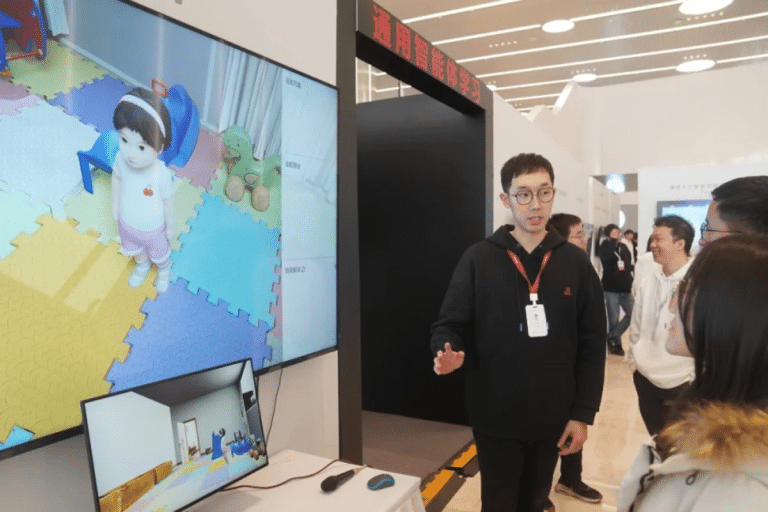
Almost everyone in the artificial intelligence space knows that China is quickly becoming one of the world’s leaders in emerging technology. This is largely due to the state-sponsored campaigns that have championed those companies that can utilise AI in everyday applications, which has quickly led to an uptick in startups utilising AI.
The government is also using a large amount of available demographic data and the citizens’ lack of care regarding privacy to harvest a large number of insights. In addition to this, these datasets have also gained use for other applications, such as in facial recognition cameras and social credit systems.
However, AI is far from the only vertical that is China is focused on becoming a world leader in. In the fields of AI, quantum computing, and robotics, the country that is the first to pioneer a breakthrough will undoubtedly have power over the rest of the world. Keeping this in view, robotics was made a prime focus of the “Made In China 2025” campaign, which aimed to make China the most powerful country in the world.
As per this campaign, over 50% of the nation’s manufacturing being automated by 2020, and over 75% by 2025. Join us as we take a deeper look into how robotics are being used to support China’s unstoppable engine of the economy, and the consequences of automation on individuals.
Laser-Like Focus On Robotics
China is the world’s largest exporter of manufactured products, with the likelihood of every individual using something or the other ‘Made In China’ being very high. As manufacturing is such an important facet of China’s economy, it seems only natural that they look for ways to cut costs while ensuring quality and efficiency. China put two and two together, leading to President Xi Jinping calling for a robot revolution in manufacturing.
As mentioned previously, this was a part of the Made in China 2025 campaign to increase manufacturing prowess. It was not a plan in name alone, as robotics startups began to receive funding left, right and centre from the government, incentivising the fast growth of localised robot products. Reportedly, there are over 6000 robotics startups in the country last year, demonstrating a remarkable amount of growth in a short time.
This also comes at a time when the ageing population in China is undergoing a downturn. The population, which started declining from a high of 998 million in 2014, is predicted to continue declining. One estimate is that the population can drop to 800 million in 2050. This has created a lack of labour in the world’s biggest manufacturer, leading to a slowdown in growth.
Moreover, wages are also increasing, making it less profitable to hire humans as opposed to robots. In interior cities, is cheaper, with the average worker earning about CNY36,000 a year. In coastal areas, the wages move up to CNY60,000 a year. However, a robot which costs CNY200,000 can do the work of 3 humans, with no breaks, holidays, pensions or raises. This will allow manufacturers to recoup costs within 1 or 2 years, depending on the location of the plant.
These factors created an environment ripe for the automation revolution to begin, seeding the explosive growth of the sector.
The Outlook For The Movement
The International Federation of Robotics released a study in 2018 that showed the state of the world’s market in robotics. The findings painted a picture of unstoppable progress for China, as well as the rising theme of robotisation seen in the manufacturing sector. Moreover, it is to be kept in mind that the data is from 2017, with modern numbers being higher than what is expressed.
The robotics market is comprised of five major countries around the world, which together represent close to 75% of the world’s robotics sales volume. In 2017, the rankings put China at the top, followed by Japan, South Korea, the United States and Germany. China alone accounted for more than half of the total supply that year, with 36% of robots bought by China up from 30% in 2016.
In 2017 alone, 137,900 industrial robots were sold to China. This represents a 59% growth from 2016 and is more than the total sales volume of Europe and the Americas together, which comes up to 112,400 units. There is also a rise in the number of robots that were manufactured by Chinese companies, which saw a 29% increase from the previous years’ manufactured pieces. In 2017, foreign companies that supplied robots to China saw a sales increase of 72% in China. At the same time, the market share of local suppliers saw a reduction from 31% to 25%.
Even though there are active efforts to localise the manufacturing of the parts that make up robots, it is proving to be a difficult task. An engineer who worked as a robotics integrator in a Chinese startup said in a statement to SCMP that the process was difficult.
He stated that they could not even re-assemble the robot to get it to function as the technology itself was so complex. He said, “It takes technological know-how and talent accumulated over the decades.”
Country Continues Explosive Progress
Even in the face of such setbacks, the automation engine of the country has been continuing to run, as seen by the increasing sales of foreign companies. Many manufacturers in China have begun introducing robotics, increasing margins and recouping costs quickly.
For example, iPhone assembler Foxconn introduced robotics in the iPhone manufacturing process. Through robots known as Foxbots, they not only eliminated 400,000 jobs but also increased operating revenues. A company was known as Geekplus also make logistics and warehousing solutions. Their robots are used to sort, pick and move inventory, with their systems reducing headcount needs by 50% to 80% and floor space by 30%.
The robots also provide multiple benefits over humans, as mentioned previously. With no holidays and perfect efficiency, adding robots also reduces the risk of employees moving away from the organisation and leaving an important position unfilled. The automation engine of the country continues to increase efficiency and productivity while reducing human labour. Organisations in the country have been trying to envision the damage done to humans from the explosion of automation.
Solutions include taxing robots and putting the money into monetary support vehicles for a large number of unemployed citizens. However, China seems focused on the future and at the nectar of being a ‘world power’. Only the future will tell the story of the impact of robots and the last generation of the human assembly line.

















































































